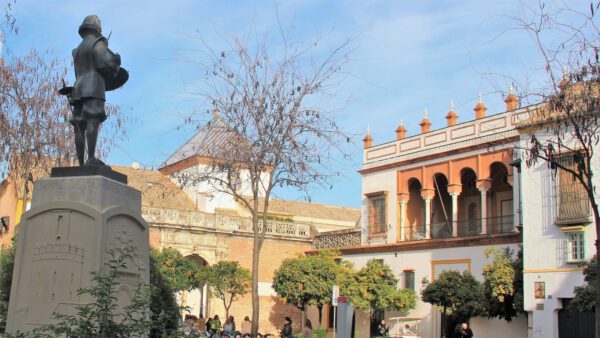PILATOS SQUARE
Next to the one that was surely the
layout of the Decumano Maximo of the Roman Seville and to the height of the
present one, they build at the end of the XV century his palace D. Pedro
Enríquez -Adelantado Mayor de Andalucía- and his wife Dª Catalina de Ribera. It
is then when, in order to achieve a certain amplitude in front of him, to give
him greater prominence, they buy several houses that they demolish, giving rise
to a square that will be known as Plaza del Adelantado. It is known that she
had houses with arcades and a fountain. At the end of the 16th century it will
be called the Marqués de Tarifa square, a title granted to the son of the
previous D. Fadrique Enríquez de Ribera who profoundly reformed the old palace,
especially after returning from the trip made to the Holy Land between 1518 and
1520. According to the tradition, it is then when he decides to establish a Via
Crucis that had its first station in the palace and the last in the humiliation
of the Cross of the Field and that presented a distance similar to the existing
one in Jerusalem between the Palace of Pontius Pilate and the Golgotha. Because
of this, soon the palace is known as Casa de Pilatos, (its real name is Palacio
de San Andrés), a denomination that will eventually take place after the end of
the 18th century, after being also known as Plaza del Duque de Alcalá. title
granted by Felipe II to Per Afán de Ribera, another of the descendants of the
former Major Adelantado, which will later be included among those held by the
Ducal House of Medinaceli, its current owner.
The palace is an interesting building that shows the first
manifestations of the Italian Renaissance in Seville, especially its cover,
giving rise to a group that today is an essential piece of Mudejar and
plateresque Sevillians. After the reforms of Per Afán de ribera, viceroy of
Naples, it also houses a good collection of Italian marbles. It also has
interesting gardens inside. The square lacks a fountain today, the one it had
at the end of the 19th century disappeared. It has undergone numerous reforms among
which include the 1860 in which acacias are planted and is endowed with seats
and gas lamps. In 1873 it is the object of the plantation of orange trees that,
together with the acacias, are maintained until today. In 1977 the Plaza de
Pilatos was remodeled again, installing its current paving.
The square has two spaces or different areas separated
by a stretch of road that joins the streets San Esteban and Aguilas. The first
of them is an enclosure of approximately triangular plant next to the building
of the palace, landscaped with orange trees that in their alcorques have been
recently adorned with masstero of bonetero (Euonymus japonicus) and with paving
of enchinado. The other space, of greater dimensions and trapezoidal plant
located on the other side, is the square itself. It is surrounded by buildings
on three sides, leaving free the corresponding to the aforementioned road,
which allows access to vehicles from San Esteban Street. These can surround the
plaza on a cobbled road with granite, and return to join the traffic to Aguilas
Street or Stables.
The gardening of this area is presided over by the monument to Zurbarán on a pedestal stone, (originally installed during the Ibero-American Exposition in the Extremadura Pavilion next to the avenue of Portugal) that presents the peculiarity of having at its base a flowerbed delimited by a small interior hedge of pitosporo and four specimens, in the corners, of lady at night (Cestrum nocturnum), which with its penetrating aroma contribute to make this place a relaxing haven in the warm Sevillian nights, only disturbed by the traffic of the street San Esteban This formula of the bed was frequent in many places of the XIX and that were organized around a central monument, being today only here and in the Museum (both reformed). The vegetation is completed with three palm trees (Phoenix canariensis) in raised circular basins and on which gracefully jasmine white climbing (Jasminum officinale). It is curious its triangular arrangement around the monument, instead of the usual square.
With the last reform of the square, which endowed it with isolated foundry banks – instead of the old stone ones – black acacias (Gleditsia triacanthos var. Inermis) have been planted in the perimeter, which have replaced the previous ones with thorns. The paving combines square stone pieces of Sierra Elvira, with small enchinados, also square, that form a checkerboard with the previous ones and coming, for the most part, from the aforementioned reform carried out by the municipal architect Amalio Saldaña.


